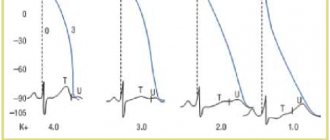Synonyms: Fibrin degradation fragment, D-dimer, Fragment D-dimer, Fibrin degradation fragment.
Scientific editor: M. Merkusheva, PSPbSMU named after. acad. Pavlova, medical practice.
D-dimer is a protein fraction, the result of fibrin breakdown during the process of dissolving blood clots (fibrinolysis). D-dimer is considered a fairly informative indicator of thrombus formation, since the mechanism of its production starts simultaneously with the process of thrombus formation.
The D-dimer test allows you to evaluate two factors in combination: coagulation (blood clotting) and fibrinolysis (dissolution of clots). The marker makes it possible to promptly detect an imbalance between them in the case of diseases of the circulatory system (varicose veins, thrombophilia, pulmonary embolism, etc.).
General information
Violation of the integrity of blood vessels is usually accompanied by bleeding, which requires fibrin to stop. This protein is involved in the formation of blood clots (thrombi), and they, in turn, plug bleeding gaps.
An increase in the concentration of fibrin in the blood provokes the formation of more blood clots than necessary. This condition is fraught with the development of thrombosis of veins and arteries. To regulate the process, the body produces a special enzyme, plasmin, which dissolves excess fibrin. The result of this chemical reaction is D-dimer. Its level should be directly proportional to the intensity of fibrinolysis.
The following factors can affect the formation of D-dimer:
- volume of dissolved thrombus;
- the period from the onset of the disease to the moment of taking anticoagulants (D-dimer begins to decrease during treatment);
- prescribing thrombolytic therapy (D-dimer increases).
In a healthy person, the concentration of D-dimer is stable (not higher than 243 ng/ml). Increased values may reflect the onset of coagulation. Also, pathologies of this process are possible with DIC syndrome, pulmonary embolism, venous thrombosis, heart disease, massive burns, serious surgical interventions, etc.
D-dimer increases in pregnant women, elderly people, cancer patients, as well as in bedridden patients (with prolonged immobilization), as well as in patients with high levels of rheumatoid factor in rheumatoid arthritis.
Although D-dimer is an important marker of thrombosis and related conditions, it has only recently become part of a comprehensive blood test - coagulogram. And since this test is more than 98% indicative, D-dimer is often determined in the emergency department to exclude thromboembolism (acute blockage of blood vessels by blood clots) in “severe” patients.
In the process of interpreting the study results, not only the concentration of D-dimer in the blood is analyzed, but also its dynamics, which makes it possible to evaluate the effectiveness of the therapy, as well as predict the risk of developing acute complications of thrombosis.
D-dimer: what kind of analysis is it?
Checking the condition of the blood and the possible presence of clots in it is carried out using a blood test. There are two types of tests:
- Quantitative - reveals whether the D-dimer level is elevated or within the normal range. The results show o (increased) or “no” (normal).
- Qualitative - the exact number of D-dimer is indicated in numbers.
Quantitative analysis is more informative and provides doctors with more information about the condition of the patient's bloodstream. During the treatment of hemostasis, the analysis is carried out several times. If the indicator decreases, it means that the blood clot is dissolving and the patient is recovering. But high-quality analysis is cheaper and therefore more accessible to patients.
The test result will allow the doctor to accurately determine the risk of cardiovascular and cancer diseases in a particular patient.
Indications for analysis
The D-dimer test is carried out as part of a coagulogram, which involves drawing blood from a vein.
The main indications for analysis are the following:
- Age over 80 years;
- General diagnosis of thrombotic conditions;
- Diagnosis of related diseases: DIC syndrome;
- deep vein thrombosis;
- pulmonary thromboembolism;
- cerebrovascular accidents (stroke);
- heart attack, etc.;
- threat of miscarriage;
The following symptoms may indicate the need for research:
Symptoms of deep vein thrombosis:
- swelling, pain and numbness in the area of one or two lower extremities, increasing with physical activity;
- pallor or cyanosis of the skin in the area of thrombosis.
Symptoms of pulmonary embolism
- sudden shortness of breath,
- difficulty breathing,
- hemoptysis,
- chest compression;
- sharp pain in the chest.
During pregnancy:
- headaches, toxicosis, weakness, swelling, high blood pressure and protein in the urine in pregnant women;
And other symptoms:
- tachycardia, arrhythmia and pain in the heart;
- bleeding of unknown etiology;
- severe pain in muscles and abdomen;
- urinary disorders (reduced urination), etc.
- cyanosis of the skin.
D-dimer standards
Standard reference values:
The common unit of measurement is µg FEU/ml
- Normally, D-dimer should not exceed 0.55 μg FEU/ml.
Reference values during pregnancy:
| Week of pregnancy | Reference values |
| Until 13th | 0 - 0.55 µg FEU/ml |
| 13-21st | 0.2 - 1.4 µg FEU/ml |
| 21st-29th | 0.3 - 1.7 µg FEU/ml |
| 29-35th | 0.3 - 3 µg FEU/ml |
| More than 35 | 0.4 - 3.1 µg FEU/ml |
The standards of the Invitro laboratory, Invitro values, are somewhat different from the standard ones, since the more modern equipment of this laboratory allows measurements to be taken with greater accuracy.
The unit of measurement in Invitro is ng/ml.
- The normal D-dimer level is less than 243 ng/ml.
Threshold values for pregnant women in Invitro:
| Trimester | D -dimer, ng/ml |
| 1st | up to 286 |
| 2nd | up to 457 |
| 3rd | up to 644 |
Note:
if the analysis shows a sharp increase in the level of D-dimer, then it is necessary to exclude a significant number of blood clots in the bloodstream.
This condition occurs with venous thromboembolism (blockage of veins by blood clots), DIC syndrome (thrombosis in small vessels). However, it is important to understand that the D-dimer test cannot determine the location of blood clots, their size or number. Important! The interpretation of the results is always carried out comprehensively. It is impossible to make an accurate diagnosis based on only one analysis.
Rumyantseva, md.
This article was written based on materials from a lecture and article by phlebologist Evgeniy Ilyukhin; the original article can be found at the link.
This article deals with a complex topic, but its relevance is growing, as is the level of panic around high D-dimer levels during pregnancy. So, let's try to figure it out:
- what is D-dimer,
- what are its normal values during pregnancy,
- who needs to be tested for it,
- in what situations treatment is required.
What is D-dimer?
More precisely, D-dimers.
D-dimers are fragments of fibrin that breaks down, which, in turn, is the basis for the formation of blood clots. In the blood coagulation system, the formation and splitting of fibrin threads constantly occurs, and an increase in the level of D-dimer indirectly indicates a potentially increasing possibility of thrombus formation (at least, this is how an increase in the level of D-dimer is interpreted when prescribing therapy during pregnancy). During pregnancy, the level of D-dimer in the blood increases, and of course, everyone is concerned with the question of what increase can be considered normal, and when is it time to start sounding the alarm and take active action?
Why is everyone so afraid of “blood clotting” during pregnancy?
Fear is associated with an increased risk of venous thromboembolic complications (VTEC) in principle during pregnancy and the postpartum period, in the context of which D-dimer is considered. Deep vein thrombosis and pulmonary embolism (common name - VTEC) during pregnancy are not a horror story, but very real serious pathologies that can lead to the most severe consequences, including death, in a pregnant woman/who has recently given birth. VTE occurs with a frequency of 1.9 cases per 1000 pregnancies! Experts know that the postpartum period is more dangerous than the pregnancy period in terms of the development of VTEC.
All that remains is to figure out whether it is possible to equate the increasing level (and which one) of D-dimer and the risk of VTEC.
D-Dimer Level Units
When talking about D-dimer, we are talking about its concentration, or rather about their concentration (D-dimers). That is, the weight of D-dimers in a certain volume. Accordingly, these can be any units of weight and any units of volume. And any “combinations” of them. Usually weight is indicated in ng, mg, mcg. Volume: in ml or l. Accordingly, you can see the following entry:
300 ng/ml = 300 µg/l = 0.3 µg/ml = 3.0 mg/l
There are also "D-Dimer Units", DDU, and "Fibrinogen Equivalent Units", FEU. The difference is simple, 1 FEU mass = ½ DDU. So 600 ngFEU/ml = 300 ngDDU/ml.
In total, from the many options for units of measurement, we have the following correspondences:
300 ng/ml = 300 μg/L = 3.0 mg/L = 0.3 μg/ml = 600 ng FEU/ml = 600 μg FEU/L = 0.6 μg FEU/ml
As you can see, there are many options for units of measurement, so you need to be very careful when comparing results obtained at different times in different laboratories.
There is another bottleneck in determining D-dimer levels: different tests have different sensitivity and reproducibility.
This means that if we measure the D-dimer level (in the same units!) with different devices in the same patients, we will get different values with a very large scatter! That is, we can trust the obtained values only with a very large assumption.
What are normal D-dimer levels during pregnancy?
Are there normal D-dimer levels for pregnant women?
If you search on the Internet, you can find a huge number of resources with tables of norms by trimester. Particularly credible is the fact that such signs are on the websites of large laboratory networks. The only problem is that even in large laboratories, the norms for D-dimer during pregnancy differ by 2 times (in the same units of measurement!). Who to believe? Let's see what major international studies say about this.
It turns out that there can be no talk of any reference values for the D-dimer level.
The main reasons for this are as follows:
1) Different tests give a colossal spread of values. In different tests in the first trimester, D-dimer values differ by 2 times, and at week 36 - by 5 times!
2) Figures for the concentration of D-dimers during a normal pregnancy can significantly exceed the pseudonorms that are replete with the Internet and which are given in completely official laboratory forms (for example, studies show normal values of 4.6 μg FEU / ml, while in one of the largest According to Russian laboratory networks, the upper limit for the 3rd trimester is 1.23 μg FEU / ml).
So, it seems obvious that:
- no reference for D-dimer,
- tests are inaccurate
- It can increase during pregnancy, and to very high values.
Is it possible to “knock down” D-dimer during pregnancy?
It's no secret that doctors often suggest playing it safe (and this applies not only to D-dimer). Since we do not know which levels of D-dimer are “dangerous”, if it increases significantly, it is often proposed to “bring down” its level by prescribing low-molecular-weight heparins (Fraxiparin, Clexane, etc.).
Let's figure out whether it is possible to “knock down” the D-dimer?
It turns out that before birth, neither prophylactic nor even therapeutic doses of heparins have a significant effect on D-dimer levels.
Considering all of the above, it is difficult to imagine where the cunning prescriptions of heparins in the most bizarre doses in courses of several days or weeks “under the control of D-dimer” come from!
What do domestic and international recommendations say?
Let's move on to the guidelines (recommendations). First, let's look at the place of D-dimers in guides on the use of reproductive technologies, and then in sections of various guidelines on pregnancy and VTEC.
Is it recommended to determine the level of D-dimer and prescribe any treatment if it increases in the main documents on reproductive technologies (IVF, etc.)?
- 2007. Russian Association of Human Reproduction. Assisted reproductive technologies (ART) (recommendations for doctors).
There is no mention of D-dimer and heparins.
- 2012 ACCP 9th edition.
No mention of D-dimer.
- Routine VTE prophylaxis is not recommended
- For moderate to severe ovarian hyperstimulation syndrome (OHSS), it is recommended to prevent VTEC with low-molecular-weight heparins for 3 months after resolution of OHSS (No D-dimer control!)
- 2014. Russian clinical guidelines “Prevention of venous thromboembolic complications in obstetrics and gynecology” (approved by the President of the Russian Society of Obstetricians and Gynecologists on May 15, 2014)
No mention of D-dimer.
To be fair, it is worth quoting from another document that goes against all existing domestic and foreign recommendations. Separately, I would like to note that not a single provision in this document is supported by references to studies/justifications, etc. And even in the general list of references for this document there is not a single study directly or indirectly related to D-dimer!
- 2015. Diagnosis, treatment and prevention of ovarian hyperstimulation syndrome (OHSS). Clinical recommendations.
“The basis for the prevention of thrombotic complications in OHSS is the elimination of hemoconcentration. Antithrombotic therapy is indicated when laboratory signs of hypercoagulability appear. The indication for the prescription of low molecular weight heparins is an increase in the concentration of D-dimer in the blood plasma ... "
“Observation rules for OHSS. The study of IPT, MHO and APTT does not provide information to assess the risk of thrombotic complications. The most informative levels are D-dimer, AT III, and fibrinogen.”
“When OHSS manifests itself and an effective therapeutic dose is selected, hemostasiological monitoring is carried out at least twice a week, and when symptoms regress, once a week or every 10 days. The duration of therapy with low molecular weight heparins is determined by the normalization of D-dimer levels and during pregnancy can exceed 30 days.”
“Dynamic monitoring during pregnancy is indicated. Control of thrombinemia according to coagulogram data. The administration of low-molecular-weight heparins is stopped when the standard D-dimer values are reached.”
Fortunately, today these recommendations are not available on the Ministry of Health website.
D-dimer in recommendations for VTEC.
Well, now a blitz on the place of D-dimer not only in sections on reproductive technologies, but in general in various major recommendations regarding the prevention of VTEC during pregnancy.
- 2012 ACCP 9th edition.
No mention of D-dimer.
- 2012. American Thoracic Society Clinical Practice Guideline. Evaluation of Suspected Pulmonary Embolism in Pregnancy.
These recommendations are out of the ordinary. The fact is that they propose not to look not only at an increased level of D-dimer, but believe (unlike others) that a low D-dimer (within the reference range for non-pregnant women) during pregnancy does not exclude the presence of thrombosis.
- 2014. ESC guidelines on the diagnosis and management of acute pulmonary embolism.
Data on the usefulness of D-dimer in pregnancy are conflicting, the authors say. And they suggest keeping it in mind in some cases when you want to avoid radiation exposure when diagnosing suspected VTEC. An auxiliary drug of little significance with a low level of evidence.
- 2015. Reducing the Risk of Venous Thromboembolism during Pregnancy and the Puerperium from RCOG. (The Royal College of Obstetricians and Gynecologists (RCOG) Green-top Guideline No. 37a).
No mention of D-dimer.
- 2016. Diagnosis of pregnancy-associated venous thromboembolism position paper of the Working Group in Women's Health of the Society of Thrombosis and Haemostasis (GTH)
Probably the most balanced of recommendations. Authors' summary:
- Available tests are divided into moderate and highly sensitive. The test result depends significantly on the test used.
- There are no “proven” elevated D-dimer thresholds at different stages of pregnancy.
- The use of threshold values for non-pregnant women allows us to exclude clinically significant VTEC during pregnancy.
- 2017. Department of Women's Reproductive Health, Northwestern State Medical University named after. I.I. Mechnikov, St. Petersburg. Interdisciplinary expert council. Recommendations (protocol) “Management of pregnant women at risk of thrombosis and pregnancy complications due to activation of hemostatic system disorders”
- Generally compliant with RCOG 2015
- D-dimer mentioned 1 time
Authors' summary: "Anamnestic data, including a woman's obstetric, medical and family history, are leading in assessing the risk of obstetric complications ... ... compared with coagulation screening tests, including determination of D-dimer concentrations."
I hope that all of the above is convincing enough not to assess the risk of VTEC and not prescribe heparins during pregnancy based on D-dimer values.
How to assess the risks of VTEC during pregnancy and the postpartum period?
Fortunately, there are convenient algorithms for this:
Risk assessment and tactics for preventing VTEC during pregnancy:
|
prenatal prevention required |
|
consider the need for prenatal prevention |
|
|
Risk assessment and tactics for preventing VTEC in the postpartum period:
|
postpartum prophylaxis required |
|
postpartum prophylaxis is required for at least 10 days |
|
|
As you can see, when deciding on the need for thromboprophylaxis (prescribing heparins during pregnancy and the postpartum period), the level of D-dimer in the blood does not matter.
Specific medications and dosages are prescribed only by the attending physician!
Summary - basic provisions for D-dimer during pregnancy and the postpartum period:
- During pregnancy, the concentration of D-dimers increases.
- There are currently no norms or reasonable reference values for the concentration of D-dimers at different stages of pregnancy.
- High D-dimer values do not indicate an increased risk of developing VTEC.
- The use of prophylactic and therapeutic doses of low molecular weight heparins does not affect the level of D-dimers.
- The risks of developing VTEC during pregnancy and the postpartum period are assessed not by current indicators of the hemostatic system (including D-dimer), but mainly by anamnestic data.
Note. Information has now emerged and is being discussed that may lead to the recognition that routine screening for some thrombophilias is advisable.
- Drug prevention of VTEC with courses depending on hemostasis indicators is a pointless and potentially dangerous practice.
Sources
- This article was written based on materials from a lecture and article by phlebologist Evgeniy Ilyukhin, the original article can be found at the link
- Heit J. a, Kobbervig CE, James AH, Petterson TM, Bailey KR, Melton LJ Trends in the incidence of venous thromboembolism during pregnancy or postpartum: a 30-year population-based study. //Ann. Intern. Med. 2005. Vol. 143, No. 10. P. 697–706.
- Silina N., Golovina O., Smirnova O., Nikolaeva A., Papayan A. Comparison of the results of determining the level of d-dimer by various methods in women with a normal pregnancy // Journal of Obstetrics and Women's Diseases. 2011. Vol. 6. P. 74–79.
- Szecsi PB, Jørgensen M., Klajnbard A., Andersen MR, Colov NP, Stender S. Haemostatic reference intervals in pregnancy // Thromb Haemost. 2010. Vol. 103, No. 4. P. 718–727.
- Wang M., Lu S., Li S., Shen F. Reference intervals of D-dimer during the pregnancy and puerperium period on the STA-R evolution coagulation analyzer // Clin Chim Acta. Elsevier BV, 2013. Vol. 425, No. August 2011. P. 176–180.
- Murphy N., Broadhurst DI, Khashan AS, Gilligan O., Kenny LC, O'Donoghue K. Gestation-specific D-dimer reference ranges: A cross-sectional study // BJOG An Int. J. Obstet. Gynaecol. 2015. Vol. 122, No. 3. P. 395–400.
- Gong JM, Shen Y., He YX Reference Intervals of Routine Coagulation Assays During the Pregnancy and Puerperium Period // J Clin Lab Anal. 2021. Vol. 30, No. 6. P. 912–917.
- Momot A.P., Molchanova I., Batrak T., Belozerov D., Trukhina D., Kudinova I., Maksimova N., Fadeeva N., Serdyuk G., Romanov V. Reference values of parameters of the hemostatic system during physiological pregnancy and after delivery // Problems of reproduction. 2015. No. 1. P. 89–97.
- Patel JP, Patel RK, Roberts LN, Marsh MS, Green B., Davies JG, Arya R. Changes in thrombin generation and D-dimer concentrations in women injecting enoxaparin during pregnancy and the puerperium // BMC Pregnancy Childbirth. 2014. Vol. 14, No. 1. P. 384.
- Di Nisio M., Porreca E., Di Donato V., Tiboni G. Plasma concentrations of D-dimer and outcome of in vitro fertilization // J Ovarian Res. 2014. Vol. 7, No. 1. P. 58.
- Lian R., Diao L., Xu J., Mo M., Zeng Y. The effect of plasma D-dimer on assisted reproduction technology treatment and outcome // J Reprod Immunol. Elsevier Ireland Ltd, 2021. Vol. 122. P. 44.
- Linnemann B., Bauersachs R., Rott H., Halimeh S., Zotz R., Gerhardt A., Boddenberg-Pätzold B., Toth B., Scholz U., Working Group in Women's Health of the Society of Thrombosis and Haemostasis . Diagnosis of pregnancy-associated venous thromboembolism - position paper of the Working Group in Women's Health of the Society of Thrombosis and Haemostasis (GTH). //VASA. 2016. Vol. 45, No. 2. P. 87–101.
Similar
Facebook comments
Increasing values
- The presence of arterial and venous blood clots;
- Acute inflammatory or infectious process;
- Sepsis (severe infection of the body);
- Liver and kidney diseases;
- Oncological processes;
- Extensive hematomas (for example, as a result of a fall, compression, etc.).
Physiological increase in D-dimer concentration:
- normal pregnancy (moderate increase from the 1st trimester);
- pathological pregnancy (critical level of indicator);
- old age (from 80 years);
- recent surgery;
- thrombolytic treatment.
Determination of D-dimer in pregnant women
A coagulogram is a mandatory screening test during pregnancy (performed every trimester). It measures D-dimer, the level of which varies depending on the stage of pregnancy and the general health of the woman. If the concentration of a component in the blood increases, the doctor prescribes a control ultrasound and unscheduled blood tests (coagulogram) to track changes in dynamics.
On a note:
in pregnant women, D-dimer begins to increase in the early stages and by the end of the 3rd trimester it can exceed the norm by 3-4 times. In the case of complicated pregnancy (preeclampsia, gestosis, diabetes, kidney damage, etc.), its concentration reaches critical values.
High D-dimer in pregnant women may indicate:
- diabetes mellitus (glucose metabolism disorder);
- gestosis (late toxicosis);
- eclampsia and preeclampsia;
- phlebeurysm;
- liver and kidney pathologies;
- development of an acute infectious process.
All these conditions are dangerous for the health of the expectant mother and child, as they can cause serious complications: threat of miscarriage, premature birth, placental abruption, etc. If the D-dimer during pregnancy exceeds the maximum permissible norms for a long time, the woman is hospitalized in a hospital to prevent the development of thrombosis.
Content
- Problems caused by thromboembolism
- Normal d-dimer values
- Causes of increased d-dimer levels
- Interpretation of tests for d-dimer
Blood clotting is a complex process, the purpose of which is to protect a living organism from blood loss.
In the event of damage to a blood vessel, a primary thrombus, a blood clot that closes the damage, forms on average within 3 minutes. A blood clot consists of a polymer protein called fibrin and blood cells: red blood cells, platelets and white blood cells. Fibrin is formed from fibrinogen under the action of a substance called thrombin. Once thrombin acts on fibrinogen dissolved in the blood, it turns into insoluble fibrin. Fibrin thickens the blood at the site of injury, platelets and other cells settle on it. After 10 minutes, the clot thickens - this process is called retraction. The bleeding has stopped.
It would seem like an ideal mechanism. But every mechanism can have problems. Sometimes blood clots form in the lumen of intact vessels. If such a clot gets into the arteries, blood circulation may be impaired. Impaired circulation will lead to ischemia and tissue death. This is how thromboembolism develops, a condition in which blood clots enter the arteries of vital organs.
Preparing for analysis
- It is preferable to donate blood for D-dimer in the morning on an empty stomach (the last meal - 8-10 hours before the test); before the test you can drink still water.
- It is also permissible to donate blood during the day, but not earlier than 4 hours after a light meal.
- The day before taking blood, it is necessary to exclude increased psycho-emotional and physical stress, and alcohol intake.
- Do not smoke 30 minutes before the test, incl. e-Sigs.
Sources:
- Data from the independent laboratory Invitro and Helix
- Jeffrey I. Weitz; James C. Fredenburgh; John W. Eikelboom "A Test in Context: D-dimer" Journal of the American College of Cardiology 2017;70(19):2411-2420.
Read more about blood clotting indicators
- Coagulogram: main indicators
- Fibrinogen in the blood
- APTT
- Prothrombin
- Thrombin time
- D-dimer
- Lupus anticoagulant
- Antithrombin III
- Plasminogen
- Protein C
- Protein S free
- Coagulogram during pregnancy







